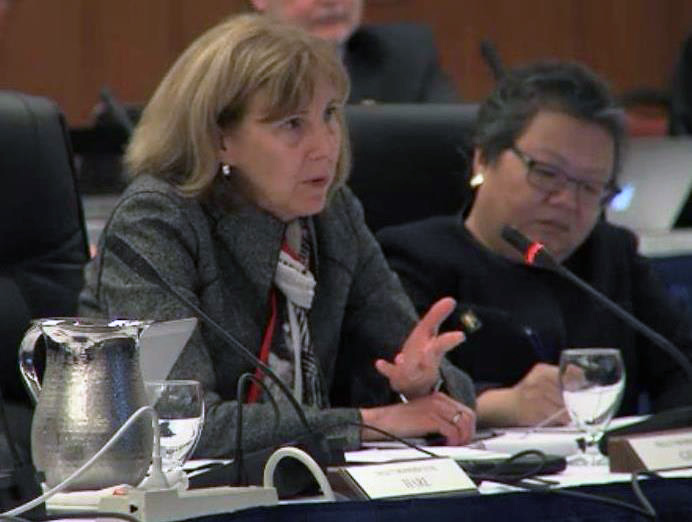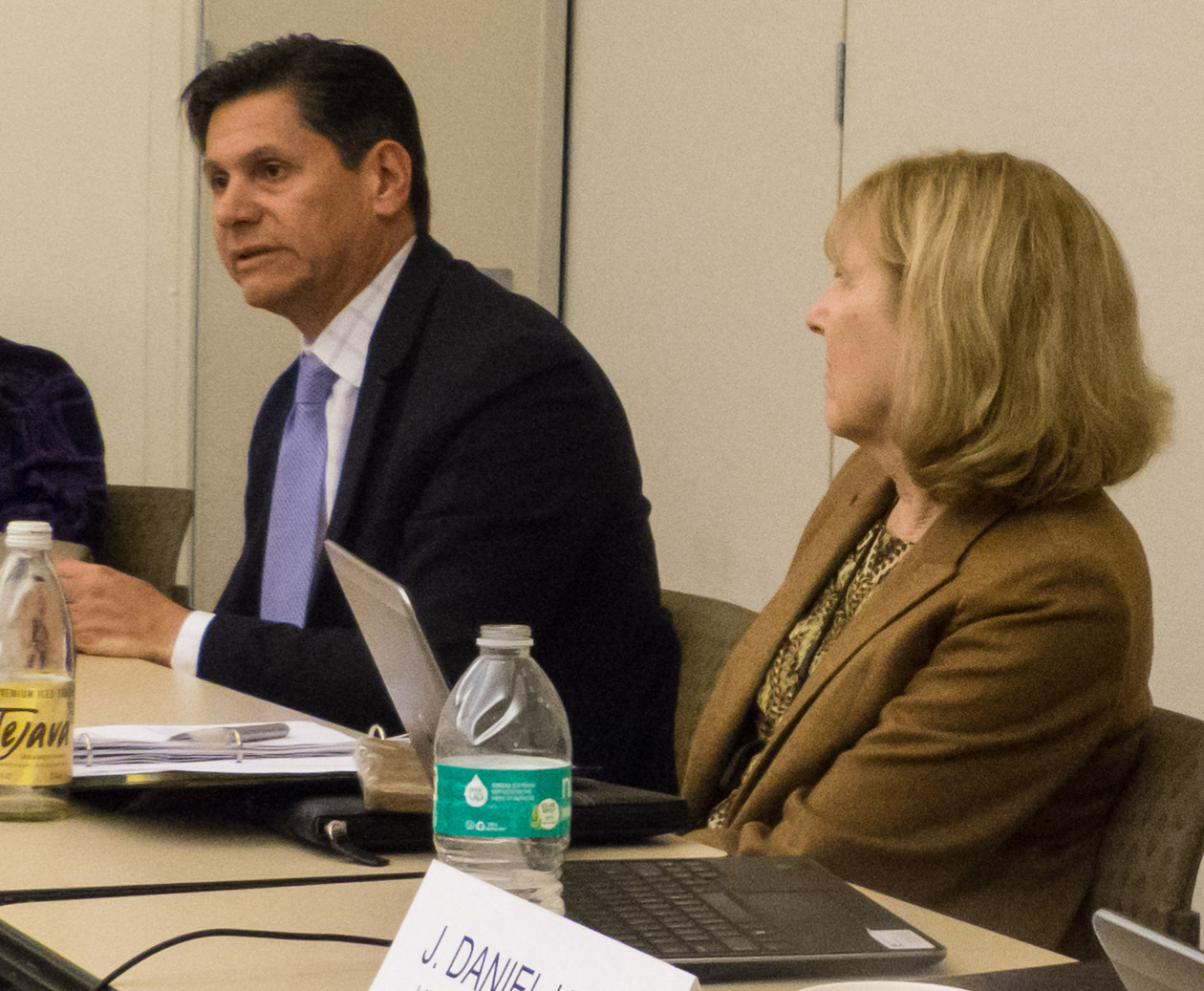May 2015
 NOTES FROM THE ACADEMIC SENATE CHAIR
NOTES FROM THE ACADEMIC SENATE CHAIR
MARY GILLY
Dear Colleagues,
It could be thought immodest of me, as the leader of the Academic Senate, to talk about the importance of the UC system to the state of California, so I will instead quote the Editorial Board of the Sacramento Bee: “The University of California may be the Golden State’s greatest public institution. It offers a pathway for talented people of modest means to vastly improve their circumstances, fosters innovation, and in many ways drives the economy.”
This “pathway for talented people of modest means” has been well-traveled over the decades. That pathway has, in fact, been a golden one for many, providing UC students access to some of the best faculty in the world. But the budget cuts of the past two decades, which culminated in the catastrophic cuts triggered by the 2008 financial crisis, are a long way from being restored, and have battered that pathway at a time when it is more critical than ever for California.
Times have changed since I arrived at UC Irvine as an assistant professor in the early 1980s when UC’s 96,000 students were overwhelmingly White and Asian (87%) and tended to be middle class. Their tuition was $0, although fees totaled around $525 per year. There was little need to focus on financial aid or student loans. Today, the UC system enrolls 239,000 students and last year received about 150,000 applications and admitted 87,000 California residents. 35% of undergraduates admitted for 2014 are from underrepresented minority groups and 37% of admitted students have low family income. Three UC campuses are now designated as Hispanic Serving Institutions.
Clearly, more Californians than ever before want to experience the quality of a UC education. UC has continued to meet its Master Plan obligation to admit the top 12.5% of California’s public high school graduates who apply, despite receiving no funding for enrollment growth in recent years. And, while tuition has increased, so has financial aid, such that half of California residents pay no tuition and nearly half leave with no student debt.
 |
| Senate Chair Mary Gilly speaks at the March 2015 Board of Regents meeting |
But our promise of a world-class education is shakier now than in the past. The student-faculty ratio has crept up, faculty remuneration has fallen farther behind our comparators, and deferred maintenance has eroded our infrastructure. A cynic might ask whether these threats to quality show that California is less committed to a more diverse student body than it was to the middle-class students of my early years at UC.
For more than a century, the state of California has allocated significant dollars to the UC system, but that money is now viewed by some officials as a “cost” or an “assessment” rather than an investment in social mobility, innovation, and economic growth, even though the return on that investment has been excellent. UC leverages taxpayer contributions with revenues from other sources to generate $46.3 billion in annual economic activity for the state.
To use an analogy that UC agriculture faculty might appreciate, the University is like an orchard. It takes many resources to start, for example, an orange orchard – the cost of the land and trees, the preparation of the land, and the labor of planting. The orchard’s value, once established, depends on unflagging care and maintenance. Ongoing costs include fertilizer, irrigation, pruning, frost protection, and pest management. But even after investing in these resources, it takes several years to produce a crop, and if the farmer scrimps on costs, the orchard will deteriorate and die. Although the orchard can survive without water and maintenance in the short term, continued neglect will lead to smaller harvests, lower-quality fruit, and cumulative losses in profitability.
For decades, California invested in its “orchard” – the University of California – by establishing ten campuses and providing the ongoing support necessary for access, growth, and quality. Similar to an orchard that produces high-quality fruit after many years of care, the state’s investment in UC has paid off. California is now the only state with six public university campuses with membership in the prestigious American Association of Universities. UC’s graduates, including Governor Brown, have made enormous contributions, and its cutting-edge research has changed the world and been a primary driver of the California economy. During the Great Recession, the state was understandably short on resources; and although UC suffered, it coped. But as the economy recovers and state revenues rise, we are now at a critical decision point: do we continue our neglect of the orchard and risk losing the value of California’s investment, or do we resume investing to cultivate future payoffs in access, innovation, economic growth, and social mobility.
 |
| Regent Eloy Ortiz Oakley visited the Academic Council on April 1, 2015 |
During another financial downturn ten years ago, a previous governor directed that students shoulder a greater portion of the cost of their education, and he crafted a budget that called for 10% annual undergraduate fee increases for three years, and even greater increases for graduate academic and professional school students. UC’s increasing reliance on tuition was shaped by that agreement. The Senate welcomes Sacramento’s new emphasis on affordability, but faculty are also on the front lines where we see exactly how educational quality is compromised by inadequate funding. Faculty know what it takes to offer a world-class education at a premiere research university, and we know that it cannot be done with what amounts to less than 2% annual increases in UC’s overall budget.
The state’s unwillingness to tend to its orchard is discouraging, but I am particularly saddened that the historic quality of a UC education is threatened just at a time when UC is welcoming a more diverse California population to the University. We have an obligation to these students, and it would be wrong to allow UC’s quality to erode just as they arrive. I agree with President Napolitano when she said, “We have a moral imperative to serve the rising generations just as we served generations of the past – from returning World War II GIs to the Baby Boomers. The students of today and tomorrow deserve the same opportunity that their predecessors had.”
To be sure, the Senate supports efforts to obtain the funding needed to meet this obligation to the state and to its students. I recently asked campus Senate offices to disseminate letters from the President to semester campus and quarter campus faculty with information and talking points about the UC budget and the Long-Term Stability Plan for Tuition and Financial Aid approved by the Regents in November. The letters encourage interested faculty to take an active role in talking publicly about how their teaching, research, and public service contribute to UC’s excellence.
We need your help to make the case that better funding for UC is a wise investment in the state’s future and will ensure that UC’s promise is extended to future generations.
Fiat Lux, Mary
